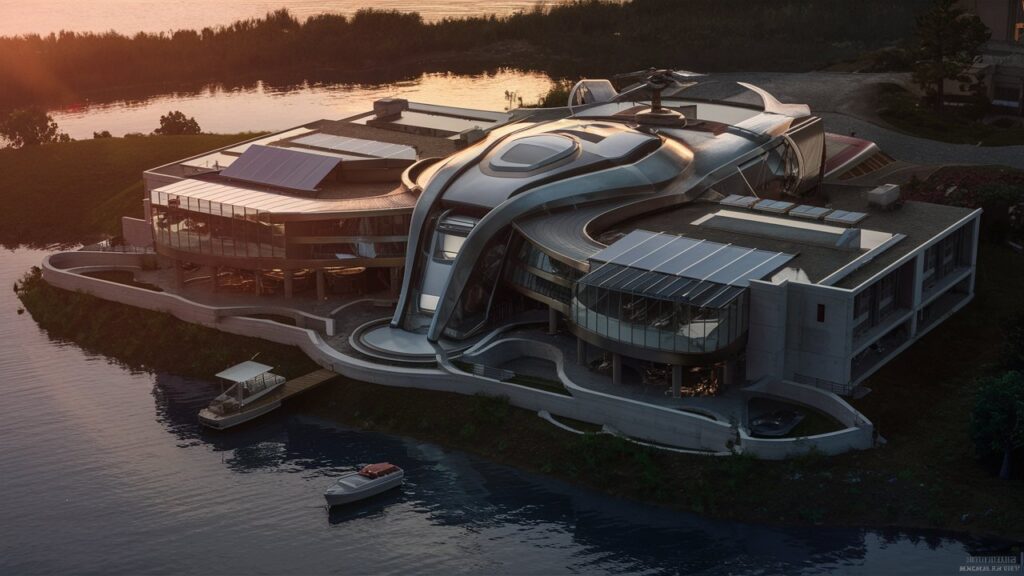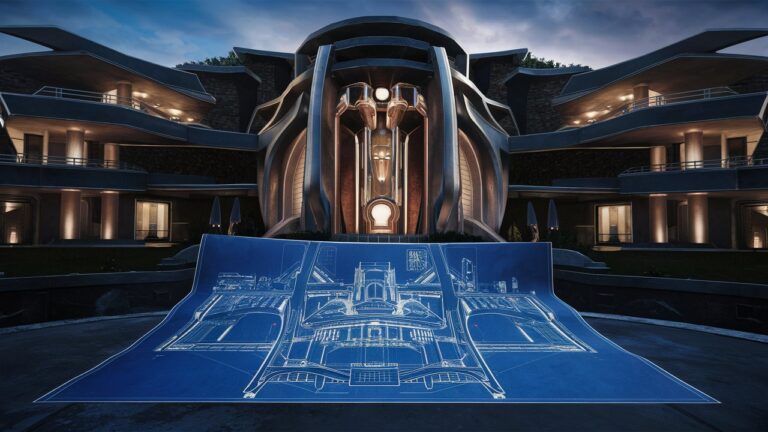Introduction: More Than a Hero’s Hideout
Tony Stark’s Malibu mansion transcends typical superhero lair tropes, embodying a fusion of cutting-edge technology, architectural audacity, and narrative significance within the Marvel Cinematic Universe (MCU). Perched dramatically on the cliffs of Point Dume at 10880 Malibu Point, this structure functions as both a character and a symbol—reflecting Stark’s genius, vulnerabilities, and evolving legacy 1212. From its role in Iron Man’s origin to its tragic destruction, the mansion remains an iconic monument to superhero storytelling.
Design Philosophy: Where Futurism Meets Function
The mansion’s design epitomizes “organic modernism,” featuring sweeping curves, asymmetrical lines, and seamless indoor-outdoor integration. Architect Wallace E. Cunningham’s real-world Razor House (La Jolla, CA) inspired its cinematic counterpart, leveraging cantilevers to create gravity-defying spaces above the Pacific Ocean 8. Key architectural elements include:
- Materials Palette: Polished concrete floors, reinforced glass walls, and titanium accents create a minimalist yet industrial aesthetic. Bulletproof glass and fortified steel beams provide hidden security 28.
- Spatial Layout: The three-story structure prioritized verticality, with a circular living room, subterranean labs, and an infinity pool merging with the horizon. Floor-to-ceiling windows amplified natural light while offering panoramic ocean views 68.
- Sustainability: Solar converters and water reclamation systems aligned with Stark’s eco-conscious tech, making the mansion self-sufficient 2.
Technological Ecosystem: The Nerve Center of Innovation
Stark’s mansion was a “smart home” decades ahead of its time, integrated with his AI J.A.R.V.I.S. (named after his childhood butler, Edwin Jarvis) 110. This system controlled every facet of the residence:
- Security Protocols: Biometric locks, retinal scanners, and an “aerial lockdown” mode could seal the mansion airtight. Intruders triggered multi-layered defenses, including suit-equipped countermeasures 17.
- Holographic Interfaces: The basement workshop featured 3D hologram projectors for suit design, global threat monitoring, and AI-assisted chemistry (e.g., synthesizing Vibranium-inspired elements) 612.
- IoT Integration: Prefiguring real-world domotics, the mansion used voice-activated climate control, automated art displays, and AI-curated entertainment systems 8.
Key Events: The Mansion as a Stage for Heroic Drama
1. Birth of Iron Man (2008)
The basement workshop birthed Stark’s Mark II–IV armors. Here, he confronted Obadiah Stane, replacing his arc reactor amid a life-or-death struggle 1. The space also hosted Nick Fury’s proposal of the Avengers Initiative—pivotal to MCU lore 3.
2. Palladium Poisoning & Rhodey’s Rampage (2010)
During Stark’s descent into palladium-induced despair, the mansion’s gym introduced Natalie Rushman (Natasha Romanoff). His self-destructive “birthday party” culminated in Colonel Rhodes seizing the Mark II armor, causing catastrophic damage to the living quarters 110.
3. The Mandarin’s Revenge (2013)
After Stark publicly challenged the terrorist, helicopter missiles reduced the mansion to rubble. The attack submerged his armory and symbolized the end of his “lone genius” era 1612.
Real-World Inspirations: From Fiction to Foundation
The Razor House (purchased by Alicia Keys for $20.8M) served as the primary architectural muse. Cunningham’s design emphasized “landscape fusion,” using the cliffside to enhance dramatic sightlines 8. Meanwhile, smart home technologies like voice-activated pergolas (StruXure), robotic lawn mowers, and AI pools now echo Stark’s fictional tech, blurring MCU fantasy and reality 8.

Legacy: The New York Mansion and Beyond
Stark’s childhood home in New York—a Gothic Revival estate—harbored Howard Stark’s secret vault of “dangerous inventions.” This location later stored Captain America’s shield and became a touchstone for Tony’s unresolved paternal relationships 1014. Though the Malibu mansion was never rebuilt, its legacy persists through:
- Avengers Compound Upstate NY: The team’s post-Ultron headquarters.
- Stark Tower: A symbol of superhero unity in Manhattan 14.
Conclusion: Engineering the Impossible
Tony Stark’s mansion remains the MCU’s most evocative non-human entity—a temple to innovation, a crucible for heroism, and a cautionary tale about vulnerability. Its destruction underscored that heroes aren’t forged in armor alone, but in spaces that reflect their ideals and flaws. As real-world tech inches toward J.A.R.V.I.S.-level AI, the mansion endures as a blueprint for tomorrow’s architecture.
Frequently Asked Questions
Q1: Why was the Malibu mansion destroyed?
It was targeted by the Mandarin after Stark issued a televised threat, using helicopters to bombard the structure into the Pacific 112.
Q2: What was the mansion’s exact address?
10880 Malibu Point, Malibu, CA 90265—a real coastal zone, though filming used the Razor House for interiors 28.
Q3: Did Stark rebuild it?
No. After its destruction, Stark relocated to Avengers Tower (NYC) and later developed the Lake Compound 12.
Q4: How did J.A.R.V.I.S. control the mansion?
Via embedded sensors, voice recognition, and a centralized AI core managing security, environment, and communications 18.
Q5: What inspired the mansion’s design?
Architect Wallace Cunningham’s Razor House, with influences from John Lautner’s Chemosphere 8.
